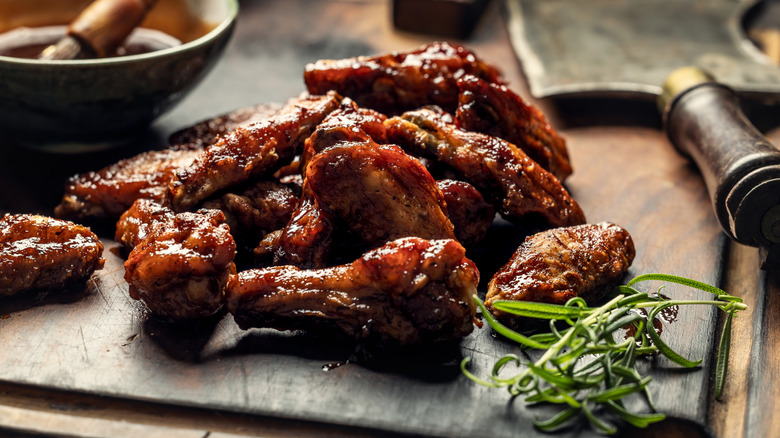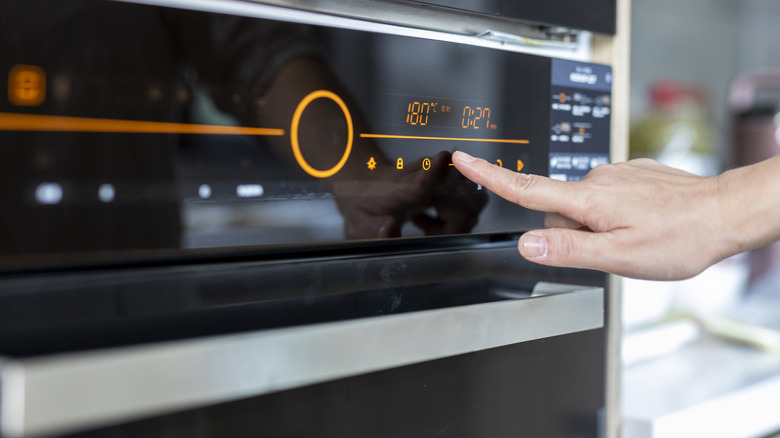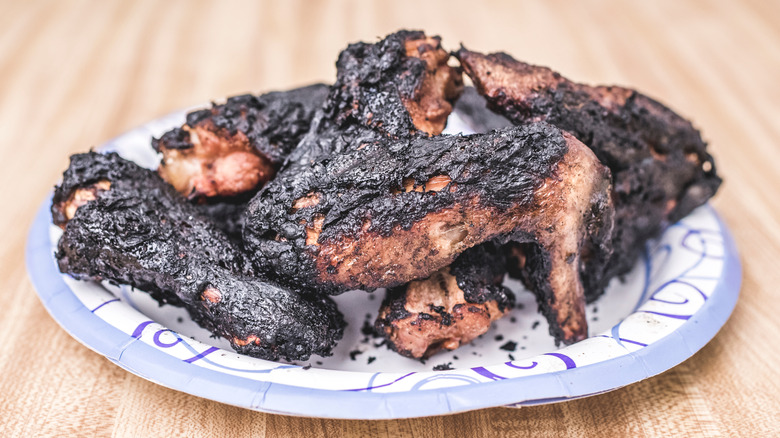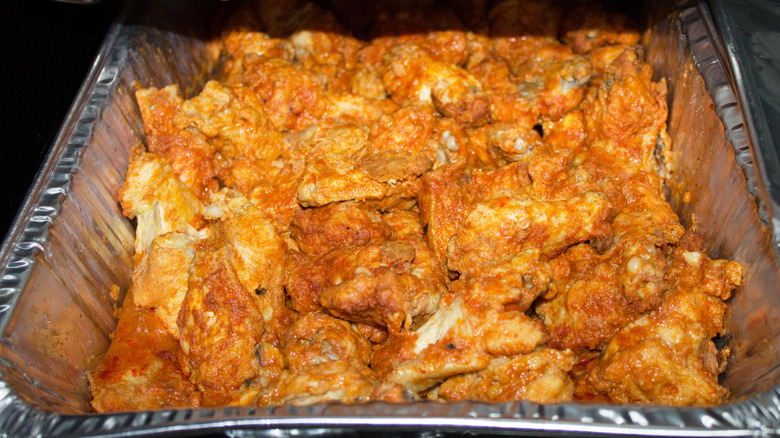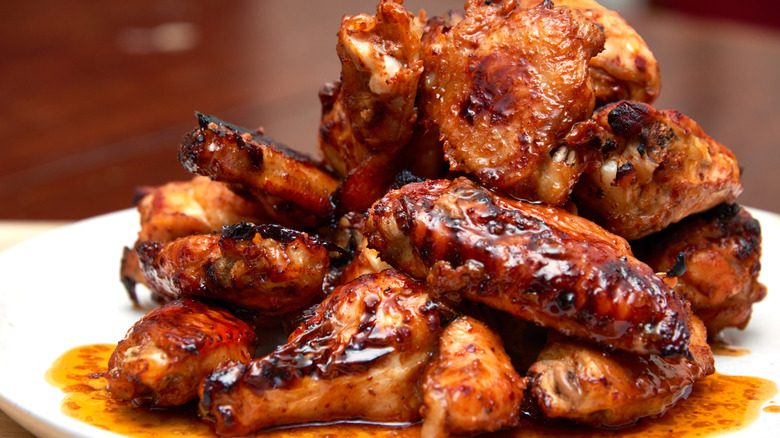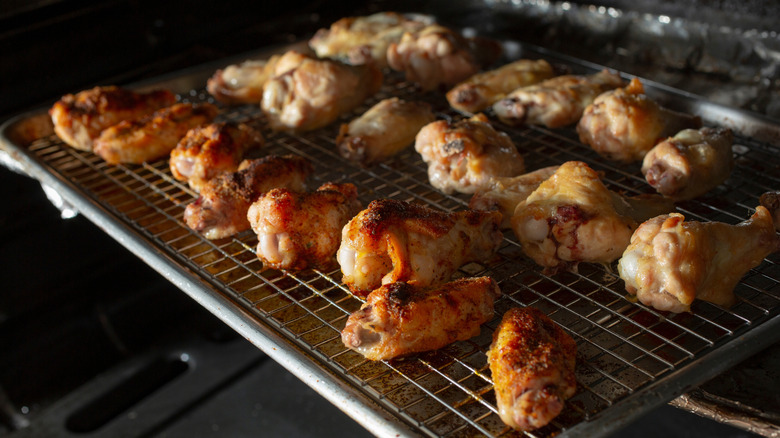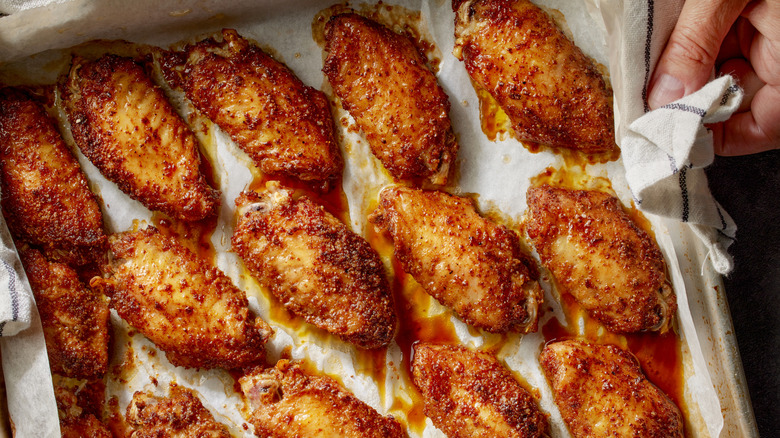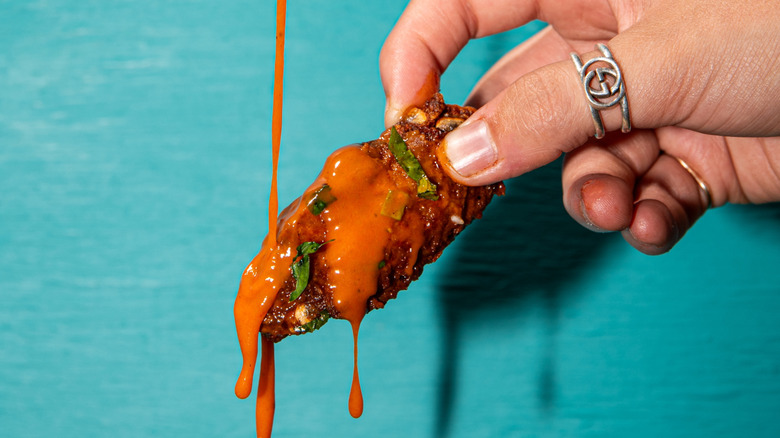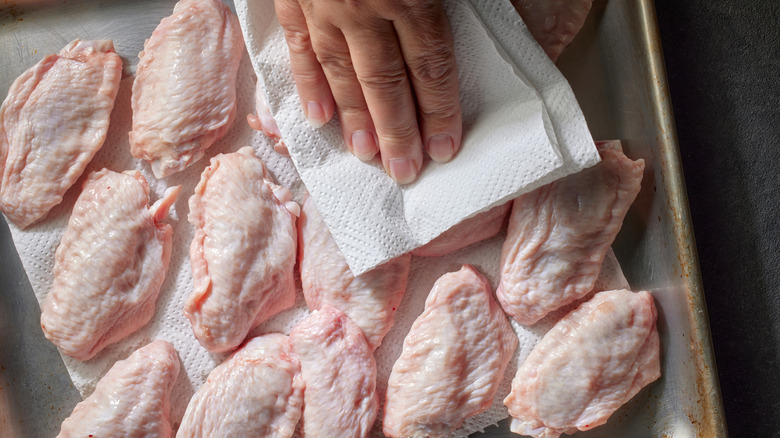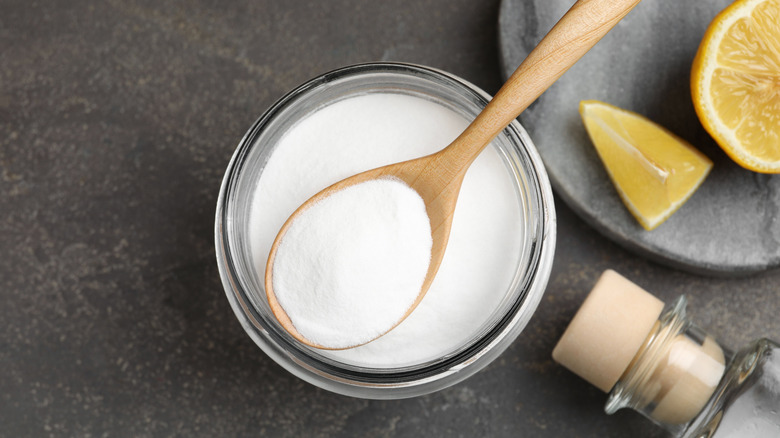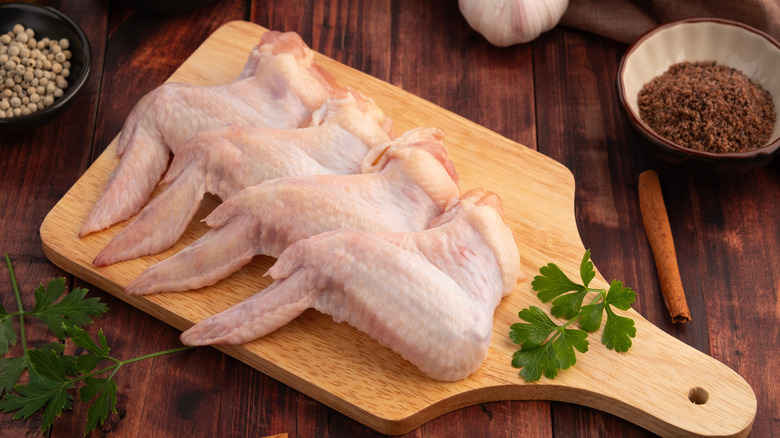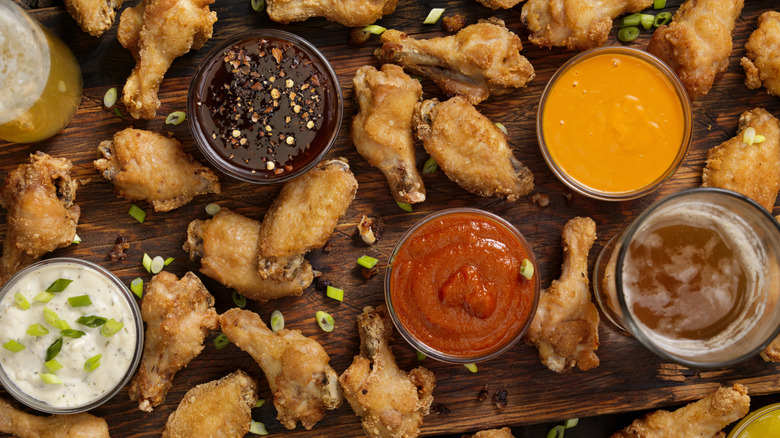11 Mistakes To Avoid When Baking Chicken Wings
We may receive a commission on purchases made from links.
There are more than a few considerations when it comes to making chicken wings. Besides choosing your favorite flavors, opting for dry rub or sauce, and calculating just how many chicken wings you need for your Super Bowl party, you'll have to decide how you want to cook them. We have tried making wings on the grill, in the air fryer, and in the oven, and oven-baked just may be our favorite method! It's less work than grilling wings on a barbecue, and while you won't get that smoky flavor, the results can be much crispier.
If you're hankering for some chicken wings but have no grill or fryer in sight, fear not. Baked chicken wings can be some of the best. In fact, baking is Guy Fieri's method of choice when it comes to cooking wings. Who doesn't love it when the easiest, most hands-off method is also the best?
You can season your wings in a variety of ways, give them the flavors you love, and have finger-licking good snacks for your next watch party or family meal. But there are a few key mistakes to avoid when preparing homemade chicken wings in the oven. Keep these in mind next time you're cooking them and you won't regret it.
Not cooking them long enough
It may surprise you given how much smaller a wing is compared to a breast or a thigh, but chicken wings can take just as long to cook as other larger pieces of meat. Don't be fooled into thinking the little morsels will be done in just 15 or 20 minutes. Crispy chicken wings will take at least 30 minutes and up to an hour, depending on the size, to cook fully in the oven.
There are a lot of bones in chicken wings — the boneless variety is not something you're likely to make at home — and more bones usually mean longer cook times. Just as bone-in chicken thighs take longer to cook than boneless thighs, those boney little wings will also take time. Bones absorb and conduct heat, extending cook times while helping the meat to cook evenly and stay juicy. When you buy whole wings, know that these larger pieces might take a bit longer to cook than wings that have been butchered down into smaller pieces.
And if you have doubts about whether or not the meat is cooked through, you can always bust out the meat thermometer and check that the wings have reached an internal temperature of at least 165 degrees Fahrenheit. But keep in mind that it can be difficult to stick a thermometer into the wing meat without touching the bone when it comes to such little pieces.
Cooking them too long
Is there anything worse than tough, dry, overcooked chicken? Maybe a mouth full of burnt carbon bits. This is true of any cut, but certainly, when it comes to wings, there is such a thing as too crispy. While it's important never to undercook poultry, you also don't want to overcook your wings. There isn't that much meat on any one chicken wing, and you'll want to keep the little morsels of meat juicy while ensuring the skin gets crisp, but not burnt.
There are several ways to ensure the wings come out nice and crispy on the outside other than just banging up the heat and roasting them forever. How you prep and season them, when you sauce them, and what equipment you use can all help. But if the oven is up at a scorching temperature, or they're left in there for too long, then the outside skin will probably burn before the inside meat gets cooked. Chicken wings should go into a preheated oven at around 400 degrees Fahrenheit. As discussed, they can take a while to cook, but make sure to pull them out before they start burning.
Crowding the pan
Here's a tip that applies to almost anything you roast in the oven. If the goal is a crisp and crunchy exterior, you don't want to crowd the pan or tray. Placing chunks of vegetables (roast potatoes, carrots, cauliflower, broccoli, Brussels sprouts, etc.), or pieces of meat like chicken thighs or wings too close together will usually have the effect of steaming rather than crisping the food. While they will cook (albeit a bit more slowly), they won't crisp. So, if you want crispy skin on your chicken wings, you won't want to place them too close together.
When baking, arrange the chicken wings in a single layer on a tray with a little bit of space between each piece. If you can't fit them all on one sheet pan, use a second tray rather than push them together. If the individual wings are touching, overlapping, and certainly if they're layered on top of one another, then the moisture released from one wing will pass to the next in the form of hot steam and the results will be soggy or mushy, but never crispy.
Over seasoning or under seasoning
Overseason your wings with too much dry rub or sauce and they can become too salty to enjoy. Lots of seasonings contain a tremendous amount of sodium. Make sure you taste any wing sauce you want to use before you dump a whole bottle of it onto the wings. You may want to cut back a little if it's super potent. When in doubt, bake your wings to crisp first and prepare the sauce on the side, to be used as a dip. That way you (and any guests you may be cooking for) can choose how much flavor to add. Likewise, be sure not to add too much salt to a homemade dry rub or you run the risk of wings that are inedible.
On the other hand, under-seasoning can yield flavorless chicken. You can brine your chicken wings ahead of time to ensure the meat is well seasoned, or you can simply add salt and pepper to flavor them. Just be sure to taste and adjust the salt levels before tossing them in another coating of seasoning. It's a bit of a Goldie Locks calculation: Not too much, not too little, but just right.
Not using a rack
Elevating chicken wings on a wire rack will help the hot air in the oven circulate around the whole piece of chicken and get things crispy on both sides. As the fat renders out, it will drip down onto the pan, and the chicken won't be left sitting in its own grease. Not that chicken fat isn't delicious.
When you're preparing to bake chicken, ask yourself if you want it to be moist and juicy or crispy and crunchy. If you want to serve plump and juicy chicken thighs drizzled with jus or gravy (to eat with a knife and fork on a plate), then, by all means, put the pieces in a deep dish to cook. Add some slices of lemon or onion and even a splash of broth.
But if you want crispy chicken wings to pick up with your fingers and nibble, you'll want to elevate them while they cook and keep them away from too much pooling moisture. Wings have a pretty high ratio of skin to meat, and if that skin stays moist, it can be rubbery and unpleasant to chew. If you have a baking rack, give it a little spray with cooking oil, pop it on top of the baking tray, and place the pieces on that before putting them into the oven.
Not using parchment paper or aluminum foil
If you don't have a rack in your kitchen arsenal, the next best option is to line your baking sheet with parchment paper or aluminum foil. This is especially important if you're baking pre-sauced wings. When placed directly onto a cookie sheet, the sugar in the wing sauce will start to caramelize and fuse to the pan, making it hard to remove the wings without tearing off the skin or even little chunks of the meat. Not to mention making it difficult to clean the pan afterward.
Even when using a wire rack, it can still be a good idea to line the baking tray with parchment paper or aluminum foil underneath. That way the drippings that burn up on the bottom of the pan will lift right off and you won't have to scrub them. Lining the tray will make cleanup much easier.
Saucing at the wrong moment
If dry rub isn't your thing and you're looking for a saucy wing to satisfy your craving, then, by all means, get some wing sauce in the mix, but it's important to know when to add it! If you want your wing to have a bit of crispy skin, then you need to think about the ideal time to add the sauce.
Consider baking the chicken wings first and then tossing them in sauce once they come out of the oven. Or bake them with just a little sauce coating, and then brush on more as you go. Throwing super saucy wings right into the oven can yield a burnt sticky mess, not crispy, crunchy wings because the sugars in the sauce can burn in the oven at temperatures as low as 260 to 274 degrees Fahrenheit. If they do, the wings will have a bitter flavor.
Forgetting to pat them dry
When you first take wings out of the package, there's usually quite a bit of moisture on them. Take some paper towels and pat them dry before seasoning. Moisture inhibits the Maillard reaction, which is what makes meat change color when it is cooked.
More moisture means more water, and that also means more steam. We've already gone over how steam keeps the skin from getting crispy, and how the moisture from too much sauce will keep wings from crisping up when you bake them. When you're going for a crunchy wing seasoned with dry rub, forgetting to pat the wings dry before tossing them in spices will certainly inhibit the crisping.
If you've marinated the wings beforehand, you're going to want to remove most of the marinade by patting the wings dry before popping them in the oven. Then, part way through the cook, you can brush them with sauce, or even wait until after they come out of the oven to toss them in it.
Leaving out the baking soda
For extra crispy wings, you'll want to use baking soda. The rising agent can also have the effect of crisping and browning chicken skin. It's funny because if you read different recipes online, some will say to use baking powder, not soda, and others reverse this directive. The truth is, you can probably use either one. But keep in mind that baking soda is more concentrated and can start to taste bitter when used in excess, so use it sparingly.
Before you put them in the oven, pat your wings dry, removing any excess moisture. Then, toss them in a bowl with just a teaspoon or two of baking soda or baking powder. Make sure it doesn't clump up all in one place and is distributed across all the chicken skin. You can add salt at this time and other dry seasonings too if you like.
Baking soda has the effect of raising the pH level and drawing moisture out of the skin. That means in the oven, the skin will crisp and bubble up more evenly without the addition of any oils. You can also try the boiling water trick to help render out some fat and get extra crispy skin on those wings.
Forgetting to trim the wings
You may already know the difference between the parts of a chicken wing: drumettes and wingettes are what you're typically served at restaurants. Many store-bought chicken wings will already be trimmed into bite-size pieces, but some wings (from the butcher or certain grocery stores) may be larger. These are whole wings kept in one piece and still have that extra bit of skin or cartilage at the wing tip. If left untrimmed, they run the risk of burning up at the edges before the rest of the wing is cooked through.
It's pretty easy to chop whole wings into their respective pieces. But when you decide to keep them whole (which is absolutely fine and maybe harder to overcook), if you see the wing tip looking a bit long, or there are stretches of skin or cartilage that don't contain any meat, feel free to get out the kitchen scissors or butcher's knife and lob those parts off. The wings will be easier to handle, won't take up as much space on the baking tray, and won't burn as easily in the oven.
Not experimenting with flavor
If you're baking wings at home, you have endless options when it comes to seasoning. You can marinate wings overnight. You can find all kinds of pre-made wing sauces, or experiment with making your own. If you love buffalo chicken wings, you can consult this list of best and worst store-bought buffalo sauces. If you like that flavor but not too much heat, grab a bottle of Frank's RedHot Mild Wing Hot Sauce on Amazon, or you can even make a buffalo sauce from scratch with this easy classic buffalo wing sauce recipe.
If you like a crispier wing, opt for a dry rub or mix your own with all sorts of spices from your cupboard. Garlic powder, paprika, ginger, cajun spice, and even celery salt can be tasty ingredients in wing seasoning. Essentially, any flavors you enjoy on chicken can work on wings. If you love Asian flavors, make a sticky-sweet soy-based sauce with a little bit of ginger, and honey or maple syrup. Or give wings tossed in chicken satay-style peanut sauce a try for something a little more unique. Serve up a few different options and there will be something for everyone at the table!
